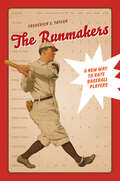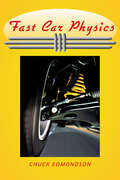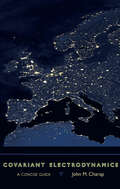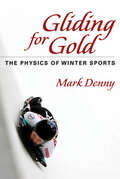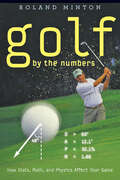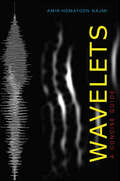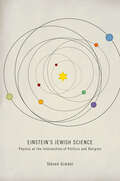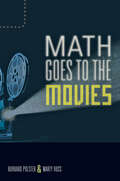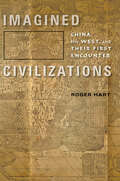- Table View
- List View
Quasi-Least Squares Regression
by Justine Shults Joseph M. HilbeDrawing on the authors' substantial expertise in modeling longitudinal and clustered data, Quasi-Least Squares Regression provides a thorough treatment of quasi-least squares (QLS) regression-a computational approach for the estimation of correlation parameters within the framework of generalized estimating equations (GEEs). The authors present a d
The Runmakers: A New Way to Rate Baseball Players
by Frederick E. TaylorStatistics are the lifeblood of baseball. Managers pore over batting averages to determine game day lineups and batting orders; high number of runs batted in and low earned run averages receive praise from the press, higher salaries from the front office, and love from fans; and the fate of fantasy baseball players rises and falls with each statistical change. The prominence of the RC/27 and other more complex, formula-driven stats has made numbers even more important to understanding and appreciating the game. For all these baseball buffs and more, Frederick E. Taylor provides a new measure of hitting prowess that just might be a game changer. Taylor's potential runs per game (PRG) measure accounts for batters getting on base, advancing runners, and driving in runs, and it separates leadoff and second batters from those in the middle of the order. Taylor introduces the measure, explains how it works, and applies it to players past and present. He breaks the history of major league baseball into eight eras based on differences in runs scored per game. He systematically—player-by-player and position-by-position—compares the results of the PRG measure to those drawn from other statistics, such as on-base percentage and slugging average. Taylor shows that PRG is more accurate and that career clutch hitting is a myth.Sabermetricians, baseball fans of all stripes, and anyone who earns a living from the sport will find a wealth of information and a whole new set of stats to obsess over in The Runmakers. Measuring baseball will never be the same.
Fast Car Physics
by Chuck EdmondsonRevving engines, smoking tires, and high speeds. Car racing enthusiasts and race drivers alike know the thrill of competition, the push to perform better, and the agony—and dangers—of bad decisions. But driving faster and better involves more than just high horsepower and tightly tuned engines. Physicist and amateur racer Chuck Edmondson thoroughly discusses the physics underlying car racing and explains just what’s going on during any race, why, and how a driver can improve control and ultimately win.The world of motorsports is rich with excitement and competition—and physics. Edmondson applies common mathematical theories to real-world racing situations to reveal the secrets behind successful fast driving. He explains such key concepts as how to tune your car and why it matters, how to calculate 0 to 60 mph times and quarter-mile times and why they are important, and where, when, why, and how to use kinematics in road racing. He wraps it up with insight into the impact and benefit of green technologies in racing. In each case, Edmondson’s in-depth explanations and worked equations link the physics principles to qualitative racing advice.From selecting shifting points to load transfer in car control and beyond, Fast Car Physics is the ideal source to consult before buckling up and cinching down the belts on your racing harness.
Covariant Electrodynamics: A Concise Guide
by John M. CharapA notoriously difficult subject, covariant electrodynamics is nonetheless vital for understanding relativistic field theory. John M. Charap’s classroom-tested introduction to the mathematical foundations of the topic presents the material in an approachable manner.Charap begins with a historical overview of electrodynamics and a discussion of the preliminary mathematics one needs in order to grasp the advanced and abstract concepts underlying the theory. He walks the reader through Maxwell’s four equations, explaining how they were developed and demonstrating how they are applied. From there, Charap moves through the other components of electrodynamics, such as Lorentz transformations, tensors, and charged particle behavior. At each point, he carefully works through the mathematics, applies the concepts to simple physical systems, and provides historical context that makes clear the connections among the theories and the mathematicians responsible for developing them. A concluding chapter reviews the history of electrodynamics and points the way for independent testing of the theory.Thorough, evenly paced, and intuitive, this friendly introduction to high-level covariant electrodynamics is a handy and helpful addition to any physicist’s toolkit.
Covariant Electrodynamics: A Concise Guide
by John M. CharapA notoriously difficult subject, covariant electrodynamics is nonetheless vital for understanding relativistic field theory. John M. Charap’s classroom-tested introduction to the mathematical foundations of the topic presents the material in an approachable manner.Charap begins with a historical overview of electrodynamics and a discussion of the preliminary mathematics one needs in order to grasp the advanced and abstract concepts underlying the theory. He walks the reader through Maxwell’s four equations, explaining how they were developed and demonstrating how they are applied. From there, Charap moves through the other components of electrodynamics, such as Lorentz transformations, tensors, and charged particle behavior. At each point, he carefully works through the mathematics, applies the concepts to simple physical systems, and provides historical context that makes clear the connections among the theories and the mathematicians responsible for developing them. A concluding chapter reviews the history of electrodynamics and points the way for independent testing of the theory.Thorough, evenly paced, and intuitive, this friendly introduction to high-level covariant electrodynamics is a handy and helpful addition to any physicist’s toolkit.
Mathematical Works Printed in the Americas, 1554–1700 (Johns Hopkins Studies in the History of Mathematics)
by Bruce Stanley BurdickThis magisterial annotated bibliography of the earliest mathematical works to be printed in the New World challenges long-held assumptions about the earliest examples of American mathematical endeavor. Bruce Stanley Burdick brings together mathematical writings from Mexico, Lima, and the English colonies of Massachusetts, Pennsylvania, and New York. The book provides important information such as author, printer, place of publication, and location of original copies of each of the works discussed. Burdick’s exhaustive research has unearthed numerous examples of books not previously cataloged as mathematical. While it was thought that no mathematical writings in English were printed in the Americas before 1703, Burdick gives scholars one of their first chances to discover Jacob Taylor’s 1697 Tenebrae, a treatise on solving triangles and other figures using basic trigonometry. He also goes beyond the English language to discuss works in Spanish and Latin, such as Alonso de la Vera Cruz's 1554 logic text, the Recognitio Summularum; a book on astrology by Enrico Martínez; books on the nature of comets by Carlos de Sigüenza y Góngora and Eusebio Francisco Kino; and a 1676 almanac by Feliciana Ruiz, the first woman to produce a mathematical work in the Americas. Those fascinated by mathematics, its history, and its culture will note with interest that many of these works, including all of the earliest ones, are from Mexico, not from what is now the United States. As such, the book will challenge us to rethink the history of mathematics on the American continents.
Unbiased Stereology: A Concise Guide
by Peter R. MoutonThis update to Peter R. Mouton’s pioneering work provides bioscientists with the concepts needed in order to apply the principles and practices of unbiased stereology to research involving biological tissues.Mouton starts with a brief explanation of the history and theory of the process before defining the terms, concepts, and tools of unbiased stereological procedures. He compares and contrasts the procedures with less-exacting approaches to quantitative analysis of biological structure using specific examples from biomedical literature. The book incorporates existing best practices with new methodologies, such as the Rare Event Protocol, while simplifying the dense, often difficult literature on the subject to show the utility and importance of unbiased stereology. This clear, insightful guide goes a step further than other books on this subject by demonstrating not only how to use unbiased stereology but also how to interpret and present the results.Written by the official U.S. representative to the International Society for Stereology, this is the most complete, up-to-date resource on the science of unbiased stereology. Those new to bioscience research as well as experienced practitioners will find that Mouton’s explanations are the perfect companion for stereology courses and workshops.
Unbiased Stereology: A Concise Guide
by Peter R. MoutonThis update to Peter R. Mouton’s pioneering work provides bioscientists with the concepts needed in order to apply the principles and practices of unbiased stereology to research involving biological tissues.Mouton starts with a brief explanation of the history and theory of the process before defining the terms, concepts, and tools of unbiased stereological procedures. He compares and contrasts the procedures with less-exacting approaches to quantitative analysis of biological structure using specific examples from biomedical literature. The book incorporates existing best practices with new methodologies, such as the Rare Event Protocol, while simplifying the dense, often difficult literature on the subject to show the utility and importance of unbiased stereology. This clear, insightful guide goes a step further than other books on this subject by demonstrating not only how to use unbiased stereology but also how to interpret and present the results.Written by the official U.S. representative to the International Society for Stereology, this is the most complete, up-to-date resource on the science of unbiased stereology. Those new to bioscience research as well as experienced practitioners will find that Mouton’s explanations are the perfect companion for stereology courses and workshops.
Gliding for Gold: The Physics of Winter Sports
by Mark DennyAs anyone from cold climates knows, living with lots of ice and snow can lead to a special appreciation of sports such as skiing, sledding, and skating. Prolific physics popularizer Mark Denny’s take on winter athletics lays out the physical principles that govern glaciated game play.After discussing the physical properties of ice and snow and describing the physics behind sliding friction and aerodynamic drag, Denny applies these concepts to such sports as bobsledding, snowboarding, and curling. He explains why clap skates would only hinder hockey players, how a curling rock curls, the forces that control luge speed, and how steering differs from skiing to snowboarding. With characteristic accuracy and a touch of wit, Denny provides fans, competitors, and coaches with handy, applicable insights into the games they love. The separate section of technical notes offers an original and mathematically rigorous exploration of the key aspects of winter sports physics. A physics-driven exploration of sports played on ice and snow that is truly fun and informative, Gliding for Gold is the perfect primer for understanding the science behind cold weather athletics.
Gliding for Gold: The Physics of Winter Sports
by Mark DennyAs anyone from cold climates knows, living with lots of ice and snow can lead to a special appreciation of sports such as skiing, sledding, and skating. Prolific physics popularizer Mark Denny’s take on winter athletics lays out the physical principles that govern glaciated game play.After discussing the physical properties of ice and snow and describing the physics behind sliding friction and aerodynamic drag, Denny applies these concepts to such sports as bobsledding, snowboarding, and curling. He explains why clap skates would only hinder hockey players, how a curling rock curls, the forces that control luge speed, and how steering differs from skiing to snowboarding. With characteristic accuracy and a touch of wit, Denny provides fans, competitors, and coaches with handy, applicable insights into the games they love. The separate section of technical notes offers an original and mathematically rigorous exploration of the key aspects of winter sports physics. A physics-driven exploration of sports played on ice and snow that is truly fun and informative, Gliding for Gold is the perfect primer for understanding the science behind cold weather athletics.
STEM the Tide: Reforming Science, Technology, Engineering, and Math Education in America
by David E. DrewOne study after another shows American students ranking behind their international counterparts in the STEM fields—science, technology, engineering, and math. Businesspeople and cultural critics such as Bill Gates warn that this alarming situation puts the United States at a serious disadvantage in the high-tech global marketplace of the twenty-first century, and President Obama places improvement in these areas at the center of his educational reform. What can be done to reverse this poor performance and to unleash America’s wasted talent?David E. Drew has good news—and the tools America needs to keep competitive. Drawing on both academic literature and his own rich experience, Drew identifies proven strategies for reforming America’s schools, colleges, and universities, and his comprehensive review of STEM education in the United States offers a positive blueprint for the future. These research-based strategies include creative and successful methods for building strong programs in science and mathematics education and show how the achievement gap between majority and minority students can be closed. A crucial measure, he argues, is recruiting, educating, supporting, and respecting America’s teachers. Accessible, engaging, and hard hitting, STEM the Tide is a clarion call to policymakers, administrators, educators, and everyone else concerned about students’ participation in the STEM fields and America’s competitive global position.
STEM the Tide: Reforming Science, Technology, Engineering, and Math Education in America
by David E. DrewOne study after another shows American students ranking behind their international counterparts in the STEM fields—science, technology, engineering, and math. Businesspeople and cultural critics such as Bill Gates warn that this alarming situation puts the United States at a serious disadvantage in the high-tech global marketplace of the twenty-first century, and President Obama places improvement in these areas at the center of his educational reform. What can be done to reverse this poor performance and to unleash America’s wasted talent?David E. Drew has good news—and the tools America needs to keep competitive. Drawing on both academic literature and his own rich experience, Drew identifies proven strategies for reforming America’s schools, colleges, and universities, and his comprehensive review of STEM education in the United States offers a positive blueprint for the future. These research-based strategies include creative and successful methods for building strong programs in science and mathematics education and show how the achievement gap between majority and minority students can be closed. A crucial measure, he argues, is recruiting, educating, supporting, and respecting America’s teachers. Accessible, engaging, and hard hitting, STEM the Tide is a clarion call to policymakers, administrators, educators, and everyone else concerned about students’ participation in the STEM fields and America’s competitive global position.
Probability without Equations: Concepts for Clinicians
by Bart K. HollandAlthough few physicians, nurses, dentists, and other health professionals perform laboratory tests themselves, they all need to be able to interpret the results as well as understand findings reported in the medical literature. A general understanding of probability and statistics is essential for those needing to make daily decisions about the significance of research data, drug interaction precautions, or a patient's positive laboratory test for a rare disease.Written with these needs in mind, Probability without Equations offers a thorough explanation of the subject without overwhelming the reader with equations and footnotes. Award-winning teacher Bart Holland presents a nontechnical treatment of intuitive concepts and presents numerous examples from medical research and practice. In plain language, this book explains the topics that clinicians need to understand:• Analysis of variance• "P-values" and the "t-test"• Hazard models• Regression and correlations• Alpha and beta errors"The Nobel prize-winning physicist Ernest Rutherford was fond of saying that if you need statistics to analyze the results of an experiment, you don't have a very good experiment. In a way he was right. However, a recurrent problem in medicine is that in a certain sense you commonly don't have a good experiment—but not because medical research scientists are generally incompetent! The nature of the data they work with is simply not as predictable as the data in some other fields, so the predictive nature of findings in medical science is generally rather imperfect."—from the introduction
Golf by the Numbers: How Stats, Math, and Physics Affect Your Game
by Roland MintonHow do the world’s greatest golfers improve their game? Practice, sure, but Roland Minton says mathematics and statistics are also key to their success. Golf by the Numbers analyzes the mathematical strategies behind the sport, giving fans a behind-the-scenes look at how numbers drive the game.Computers, GPS trackers, swing simulators, and high-speed cameras have introduced new and exciting ways of seeing and understanding the complicated and endlessly fascinating game of golf. Players like Phil Mickelson are so good because they review the results of every swing they take. Minton’s comprehensive analysis of statistics taken from the PGA Tour’s ShotLink system walks readers through the mountains of data that pros use to inform and refine their play. The result is an insider’s perspective of how the world’s greatest golfers apply mathematics to the sport.Minton discusses randomness in golf (especially how much luck is involved in putting) as well as aggressive and cautious strategies both on and off the greens, and he explains, by the numbers, just how Tiger Woods was so dominant from 2004 to 2009.Here is a book that tells some truly engaging stories of modern golf, featuring famous players and memorable tournaments, all through the lens of elementary probability theory. Minton’s informal style and clear and direct explanations make even the most detailed discussions accessible to all curious-minded golfers. His mathematical morsels are not only enjoyable to read—they may even help you improve your game.
Golf by the Numbers: How Stats, Math, and Physics Affect Your Game
by Roland MintonHow do the world’s greatest golfers improve their game? Practice, sure, but Roland Minton says mathematics and statistics are also key to their success. Golf by the Numbers analyzes the mathematical strategies behind the sport, giving fans a behind-the-scenes look at how numbers drive the game.Computers, GPS trackers, swing simulators, and high-speed cameras have introduced new and exciting ways of seeing and understanding the complicated and endlessly fascinating game of golf. Players like Phil Mickelson are so good because they review the results of every swing they take. Minton’s comprehensive analysis of statistics taken from the PGA Tour’s ShotLink system walks readers through the mountains of data that pros use to inform and refine their play. The result is an insider’s perspective of how the world’s greatest golfers apply mathematics to the sport.Minton discusses randomness in golf (especially how much luck is involved in putting) as well as aggressive and cautious strategies both on and off the greens, and he explains, by the numbers, just how Tiger Woods was so dominant from 2004 to 2009.Here is a book that tells some truly engaging stories of modern golf, featuring famous players and memorable tournaments, all through the lens of elementary probability theory. Minton’s informal style and clear and direct explanations make even the most detailed discussions accessible to all curious-minded golfers. His mathematical morsels are not only enjoyable to read—they may even help you improve your game.
Wavelets: A Concise Guide
by Amir-Homayoon NajmiIntroduced nearly three decades ago as a variable resolution alternative to the Fourier transform, a wavelet is a short oscillatory waveform for analysis of transients. The discrete wavelet transform has remarkable multi-resolution and energy-compaction properties. Amir-Homayoon Najmi’s introduction to wavelet theory explains this mathematical concept clearly and succinctly. Wavelets are used in processing digital signals and imagery from myriad sources. They form the backbone of the JPEG2000 compression standard, and the Federal Bureau of Investigation uses biorthogonal wavelets to compress and store its vast database of fingerprints. Najmi provides the mathematics that demonstrate how wavelets work, describes how to construct them, and discusses their importance as a tool to investigate and process signals and imagery. He reviews key concepts such as frames, localizing transforms, orthogonal and biorthogonal bases, and multi-resolution. His examples include the Haar, the Shannon, and the Daubechies families of orthogonal and biorthogonal wavelets.Our capacity and need for collecting and transmitting digital data is increasing at an astonishing rate. So too is the importance of wavelets to anyone working with and analyzing digital data. Najmi’s primer will be an indispensable resource for those in computer science, the physical sciences, applied mathematics, and engineering who wish to obtain an in-depth understanding and working knowledge of this fascinating and evolving field.
Wavelets: A Concise Guide
by Amir-Homayoon NajmiIntroduced nearly three decades ago as a variable resolution alternative to the Fourier transform, a wavelet is a short oscillatory waveform for analysis of transients. The discrete wavelet transform has remarkable multi-resolution and energy-compaction properties. Amir-Homayoon Najmi’s introduction to wavelet theory explains this mathematical concept clearly and succinctly. Wavelets are used in processing digital signals and imagery from myriad sources. They form the backbone of the JPEG2000 compression standard, and the Federal Bureau of Investigation uses biorthogonal wavelets to compress and store its vast database of fingerprints. Najmi provides the mathematics that demonstrate how wavelets work, describes how to construct them, and discusses their importance as a tool to investigate and process signals and imagery. He reviews key concepts such as frames, localizing transforms, orthogonal and biorthogonal bases, and multi-resolution. His examples include the Haar, the Shannon, and the Daubechies families of orthogonal and biorthogonal wavelets.Our capacity and need for collecting and transmitting digital data is increasing at an astonishing rate. So too is the importance of wavelets to anyone working with and analyzing digital data. Najmi’s primer will be an indispensable resource for those in computer science, the physical sciences, applied mathematics, and engineering who wish to obtain an in-depth understanding and working knowledge of this fascinating and evolving field.
Einstein's Jewish Science: Physics at the Intersection of Politics and Religion
by Steven GimbelIs relativity Jewish? The Nazis denigrated Albert Einstein’s revolutionary theory by calling it "Jewish science," a charge typical of the ideological excesses of Hitler and his followers. Philosopher of science Steven Gimbel explores the many meanings of this provocative phrase and considers whether there is any sense in which Einstein’s theory of relativity is Jewish. Arguing that we must take seriously the possibility that the Nazis were in some measure correct, Gimbel examines Einstein and his work to explore how beliefs, background, and environment may—or may not—have influenced the work of the scientist. You cannot understand Einstein’s science, Gimbel declares, without knowing the history, religion, and philosophy that influenced it. No one, especially Einstein himself, denies Einstein's Jewish heritage, but many are uncomfortable saying that he was being a Jew while he was at his desk working. To understand what "Jewish" means for Einstein’s work, Gimbel first explores the many definitions of "Jewish" and asks whether there are elements of Talmudic thinking apparent in Einstein’s theory of relativity. He applies this line of inquiry to other scientists, including Isaac Newton, René Descartes, Sigmund Freud, and Émile Durkheim, to consider whether their specific religious beliefs or backgrounds manifested in their scientific endeavors. Einstein's Jewish Science intertwines science, history, philosophy, theology, and politics in fresh and fascinating ways to solve the multifaceted riddle of what religion means—and what it means to science. There are some senses, Gimbel claims, in which Jews can find a special connection to E = mc2, and this claim leads to the engaging, spirited debate at the heart of this book.
Math Goes to the Movies
by Burkard Polster Marty RossMel Gibson teaching Euclidean geometry, Meg Ryan and Tim Robbins acting out Zeno's paradox, Michael Jackson proving in three different ways that 7 x 13 = 28. These are just a few of the intriguing mathematical snippets that occur in hundreds of movies. Burkard Polster and Marty Ross pored through the cinematic calculus to create this thorough and entertaining survey of the quirky, fun, and beautiful mathematics to be found on the big screen. Math Goes to the Movies is based on the authors' own collection of more than 700 mathematical movies and their many years using movie clips to inject moments of fun into their courses. With more than 200 illustrations, many of them screenshots from the movies themselves, this book provides an inviting way to explore math, featuring such movies as:• Good Will Hunting• A Beautiful Mind• Stand and Deliver• Pi• Die Hard• The Mirror Has Two FacesThe authors use these iconic movies to introduce and explain important and famous mathematical ideas: higher dimensions, the golden ratio, infinity, and much more. Not all math in movies makes sense, however, and Polster and Ross talk about Hollywood's most absurd blunders and outrageous mathematical scenes. Interviews with mathematical consultants to movies round out this engaging journey into the realm of cinematic mathematics.This fascinating behind-the-scenes look at movie math shows how fun and illuminating equations can be.
Math Goes to the Movies
by Burkard Polster Marty RossMel Gibson teaching Euclidean geometry, Meg Ryan and Tim Robbins acting out Zeno's paradox, Michael Jackson proving in three different ways that 7 x 13 = 28. These are just a few of the intriguing mathematical snippets that occur in hundreds of movies. Burkard Polster and Marty Ross pored through the cinematic calculus to create this thorough and entertaining survey of the quirky, fun, and beautiful mathematics to be found on the big screen. Math Goes to the Movies is based on the authors' own collection of more than 700 mathematical movies and their many years using movie clips to inject moments of fun into their courses. With more than 200 illustrations, many of them screenshots from the movies themselves, this book provides an inviting way to explore math, featuring such movies as:• Good Will Hunting• A Beautiful Mind• Stand and Deliver• Pi• Die Hard• The Mirror Has Two FacesThe authors use these iconic movies to introduce and explain important and famous mathematical ideas: higher dimensions, the golden ratio, infinity, and much more. Not all math in movies makes sense, however, and Polster and Ross talk about Hollywood's most absurd blunders and outrageous mathematical scenes. Interviews with mathematical consultants to movies round out this engaging journey into the realm of cinematic mathematics.This fascinating behind-the-scenes look at movie math shows how fun and illuminating equations can be.
Imagined Civilizations: China, the West, and Their First Encounter
by Roger HartAccounts of the seventeenth-century Jesuit Mission to China have often celebrated it as the great encounter of two civilizations. The Jesuits portrayed themselves as wise men from the West who used mathematics and science in service of their mission. Chinese literati-official Xu Guangqi (1562–1633), who collaborated with the Italian Jesuit Matteo Ricci (1552–1610) to translate Euclid’s Elements into Chinese, reportedly recognized the superiority of Western mathematics and science and converted to Christianity. Most narratives relegate Xu and the Chinese to subsidiary roles as the Jesuits' translators, followers, and converts. Imagined Civilizations tells the story from the Chinese point of view.Using Chinese primary sources, Roger Hart focuses in particular on Xu, who was in a position of considerable power over Ricci. The result is a perspective startlingly different from that found in previous studies. Hart analyzes Chinese mathematical treatises of the period, revealing that Xu and his collaborators could not have believed their declaration of the superiority of Western mathematics. Imagined Civilizations explains how Xu’s West served as a crucial resource. While the Jesuits claimed Xu as a convert, he presented the Jesuits as men from afar who had traveled from the West to China to serve the emperor.
Imagined Civilizations: China, the West, and Their First Encounter
by Roger HartAccounts of the seventeenth-century Jesuit Mission to China have often celebrated it as the great encounter of two civilizations. The Jesuits portrayed themselves as wise men from the West who used mathematics and science in service of their mission. Chinese literati-official Xu Guangqi (1562–1633), who collaborated with the Italian Jesuit Matteo Ricci (1552–1610) to translate Euclid’s Elements into Chinese, reportedly recognized the superiority of Western mathematics and science and converted to Christianity. Most narratives relegate Xu and the Chinese to subsidiary roles as the Jesuits' translators, followers, and converts. Imagined Civilizations tells the story from the Chinese point of view.Using Chinese primary sources, Roger Hart focuses in particular on Xu, who was in a position of considerable power over Ricci. The result is a perspective startlingly different from that found in previous studies. Hart analyzes Chinese mathematical treatises of the period, revealing that Xu and his collaborators could not have believed their declaration of the superiority of Western mathematics. Imagined Civilizations explains how Xu’s West served as a crucial resource. While the Jesuits claimed Xu as a convert, he presented the Jesuits as men from afar who had traveled from the West to China to serve the emperor.
Introduction to Differential Equations Using Sage
by David Joyner Marshall HamptonDavid Joyner and Marshall Hampton's lucid textbook explains differential equations using the free and open-source mathematical software Sage.Since its release in 2005, Sage has acquired a substantial following among mathematicians, but its first user was Joyner, who is credited with helping famed mathematician William Stein turn the program into a usable and popular choice. Introduction to Differential Equations Using Sage extends Stein's work by creating a classroom tool that allows both differential equations and Sage to be taught concurrently. It's a creative and forward-thinking approach to math instruction.Topics include: • First-Order Differential Equations • Incorporation of Newtonian Mechanics• Second-Order Differential Equations• The Annihilator Method• Using Linear Algebra with Differential Equations• Nonlinear Systems• Partial Differential Equations• Romeo and Juliet
Introduction to Differential Equations Using Sage
by David Joyner Marshall HamptonDavid Joyner and Marshall Hampton's lucid textbook explains differential equations using the free and open-source mathematical software Sage.Since its release in 2005, Sage has acquired a substantial following among mathematicians, but its first user was Joyner, who is credited with helping famed mathematician William Stein turn the program into a usable and popular choice. Introduction to Differential Equations Using Sage extends Stein's work by creating a classroom tool that allows both differential equations and Sage to be taught concurrently. It's a creative and forward-thinking approach to math instruction.Topics include: • First-Order Differential Equations • Incorporation of Newtonian Mechanics• Second-Order Differential Equations• The Annihilator Method• Using Linear Algebra with Differential Equations• Nonlinear Systems• Partial Differential Equations• Romeo and Juliet
Least Squares Data Fitting with Applications
by Per Christian Hansen Víctor Pereyra Godela SchererAs one of the classical statistical regression techniques, and often the first to be taught to new students, least squares fitting can be a very effective tool in data analysis. Given measured data, we establish a relationship between independent and dependent variables so that we can use the data predictively. The main concern of Least Squares Data Fitting with Applications is how to do this on a computer with efficient and robust computational methods for linear and nonlinear relationships. The presentation also establishes a link between the statistical setting and the computational issues.In a number of applications, the accuracy and efficiency of the least squares fit is central, and Per Christian Hansen, Víctor Pereyra, and Godela Scherer survey modern computational methods and illustrate them in fields ranging from engineering and environmental sciences to geophysics. Anyone working with problems of linear and nonlinear least squares fitting will find this book invaluable as a hands-on guide, with accessible text and carefully explained problems.Included are• an overview of computational methods together with their properties and advantages• topics from statistical regression analysis that help readers to understand and evaluate the computed solutions• many examples that illustrate the techniques and algorithmsLeast Squares Data Fitting with Applications can be used as a textbook for advanced undergraduate or graduate courses and professionals in the sciences and in engineering.

